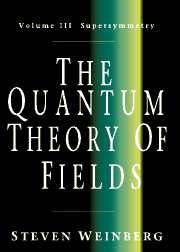Book contents
- Frontmatter
- Contents
- PREFACE TO VOLUME III
- NOTATION
- 24 HISTORICAL INTRODUCTION
- 25 SUPERSYMMETRY ALGEBRAS
- 26 SUPERSYMMETRIC FIELD THEORIES
- 27 SUPERSYMMETRIC GAUGE THEORIES
- 28 SUPERSYMMETRIC VERSIONS OF THE STANDARD MODEL
- 29 BEYOND PERTURBATION THEORY
- 30 SUPERGRAPHS
- 31 SUPERGRAVITY
- 32 SUPERSYMMETRY ALGEBRAS IN HIGHER DIMENSIONS
- AUTHOR INDEX
- SUBJECT INDEX
28 - SUPERSYMMETRIC VERSIONS OF THE STANDARD MODEL
Published online by Cambridge University Press: 05 May 2013
- Frontmatter
- Contents
- PREFACE TO VOLUME III
- NOTATION
- 24 HISTORICAL INTRODUCTION
- 25 SUPERSYMMETRY ALGEBRAS
- 26 SUPERSYMMETRIC FIELD THEORIES
- 27 SUPERSYMMETRIC GAUGE THEORIES
- 28 SUPERSYMMETRIC VERSIONS OF THE STANDARD MODEL
- 29 BEYOND PERTURBATION THEORY
- 30 SUPERGRAPHS
- 31 SUPERGRAVITY
- 32 SUPERSYMMETRY ALGEBRAS IN HIGHER DIMENSIONS
- AUTHOR INDEX
- SUBJECT INDEX
Summary
Physical phenomena at energies accessible in today's accelerator laboratories are accurately described by the standard model, the renormalizable theory of quarks, leptons, and gauge bosons, governed by the gauge group SU(3) × SU(2) × U(1), described in Sections 18.7 and 21.3. The standard model is today usually understood as a low-energy approximation to some as-yet-unknown fundamental theory in which gravitation appears unified with the strong and electroweak forces at an energy somewhere in the range of 1016 to 1018 GeV. This raises the hierarchy problem: what accounts for the enormous ratio of this fundamental energy scale and the energy scale ≈ 300 GeV that characterizes the standard model?
The strongest theoretical motivation for supersymmetry is that it offers a hope of solving the hierarchy problem. Quarks, leptons, and gauge bosons are required by the SU(3) × SU(2) × U(1) gauge symmetry to appear with zero masses in the Lagrangian of the standard model, so that the physical masses of these particles are proportional to the electroweak breaking scale, which in turn is proportional to the mass of the scalar fields responsible for the electroweak symmetry breakdown. The crux of the hierarchy problem1a is that the scalar fields, unlike the fermion and gauge boson fields, are not protected from acquiring large bare masses by any symmetry of the standard model, so it is difficult to see why their masses, and hence all other masses, are not in the neighborhood of 1016 to 1018 GeV.
- Type
- Chapter
- Information
- The Quantum Theory of Fields , pp. 179 - 247Publisher: Cambridge University PressPrint publication year: 2000



